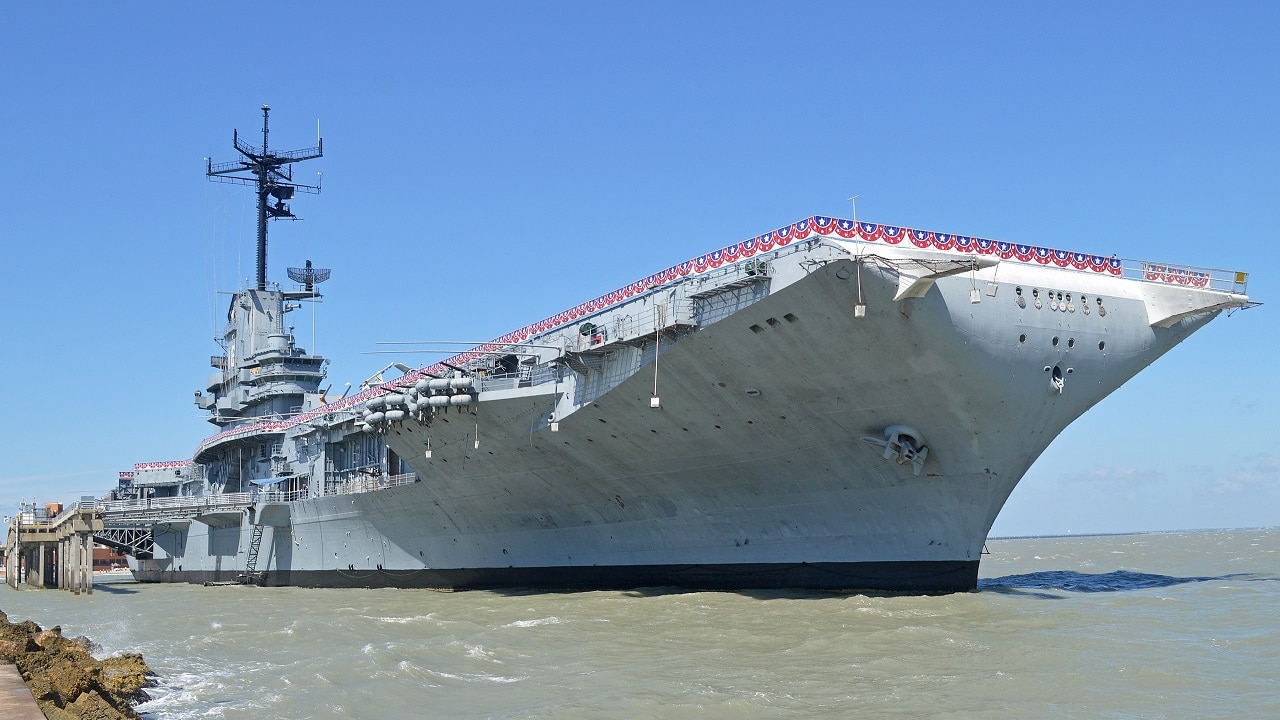Launched in September 1942, the United States Navy’s USS Lexington (CV/CAV/CVS/CVT/AVT-16) went on to have the longest career of any Essex- class aircraft carrier. She was laid down by Bethlehem Steel at Quincy, Massachusetts on July 15, 1941 with her sister ship Bunker Hill also laid down alongside that same day. Originally to be designated Cabot, her name was changed to commemorate the recently-lost USS Lexington (CV-2) – sunk at the Battle of the Coral Sea in May 1942– and became the fifth ship to bear the name in honor of the Battle of Lexington.
She entered service as CV-16 just 73 weeks later, on February 17, 1943. During the Second World War, USS Lexington served as the flagship of Task Force 58, and was present at every major engagement from Tarawa to Tokyo. At the Battle of Leyte Gulf, the greatest naval battle of the Second World War and by some accounts the great naval battle in history, the aircraft operating from the carrier were solely responsible for sinking the Imperial Japanese Navy’s (IJN’s) carrier Zuikako and the cruiser Nachi, while the aircraft shared in the destruction of the IJN’s mighty Yamato-class battleship Musashi and the carriers Chitose and Zuiho.
After hostilities ended, her aircraft continued to fly air patrols over Japan, and even located and took part in supply drops to prisoner-of-war camps on Honsh that had been abandoned by the Japanese. In December 1945, USS Lexington was used to ferry home servicemen during Operation Magic Carpet, and arrived in San Francisco on December 16.
Post-War Service
CV-16 was placed in the reserve fleet from April 1947 until September 1953, when she was transferred to Puget Sound Navy Yard for major reconstruction, which included reconfiguring her flight deck to incorporate an angled landing area along with steam catapults, provision of an enclosed foredeck, strengthening of the arrester gear, and the enlarging of her forward lift.
She was recommissioned as CVA-16 in August 1955, and rejoined the Pacific Fleet – and then redesignated as an anti-submarine carrier (CVS-16). During her “second career,” the carrier operated in the Atlantic and Pacific Oceans as well as the Mediterranean. She spent most of her time – nearly 30 years in total – on the East Coast as training carrier (CVT) until her decommissioning.
Notable Lexington Facts
USS Lexington was the final Essex-class carrier, and longest-serving of the World War II class of carriers, and she was also the last wooden-deck aircraft carrier to serve with the U.S. Navy. She had been damaged twice by Japanese air attacks, which led the Japanese to report that she was sunk no less than four times. As she always returned to the fight, Japanese propagandist Tokyo Rose nicknamed her “The Blue Ghost,” which was soon embraced by the crew and air groups that served on the carrier.
USS Lexington spent 21 months in combat, during which her aircraft destroyed 372 enemy planes in the air and another 475 on the ground. The carrier sank or destroyed 300,000 tons of enemy cargo and damaged an additional 600,000 tons. Her own guns show 15 Japanese aircraft and assisted in downing five more.
The carrier had hanger deck capacity for 103 aircraft, and of the course of her career that included F6F-3 Hellcats, SBD-6 Dauntless dive-bombers and TBF-1 Avenger torpedo bombers.
Even after her fighting days were long over, she was used as a film location at sea for the 1976 film Midway, standing in for the USS Midway (CV-5); and later for the 1988 mini-series War and Remembrance, standing in for USS Enterprise (CV-6). She was also used in the filming of the Michael Bay 2001 epic Pearl Harbor, where she was altered to serve as a Japanese carrier as well as USS Hornet (CV-8). In 2014, the carrier was used by Pepsi for a commercial in advance of the 2015 Super Bowl. Titled “ Operation Halftime,” the ad featured country-music singer Blake Shelton performing for veterans and their families.
For her World War II service, USS Lexington received the Presidential Unit Citation for heroism in action, as well as 11 battle stars for major engagements. And perhaps best of all, you visit her today as she was not broken up or sold for scrap.
Now a Senior Editor for 1945, Peter Suciu is a Michigan-based writer who has contributed to more than four dozen magazines, newspapers, and websites. He regularly writes about military hardware, and is the author of several books on military headgear including A Gallery of Military Headdress, which is available on Amazon.com. Peter is also a Contributing Writer for Forbes.

